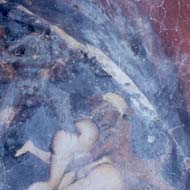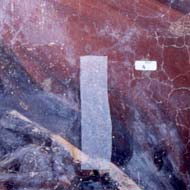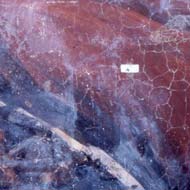 |
 |
Extraction of soluble salts |
Certain amounts of soluble or insoluble salts may
be present within any sort of masonry structure. The phenomenon of crystallisation
may occur on the surface or below the surface of a wall painting. The first
case is known as efflorescence and the deposit is visible on the surface
as a whitish patina; in the second case, crystallisation takes place within
the plaster or masonry and, due to its increased volume, causes the paint
to become detached. The aim of extraction procedures is to eliminate the
accumulation of mineral salts from the surface layer. The most frequently
used method, as long as it is compatible with the painting technique, consists
of applying moistened pads of cellulose pulp or any other material that
can easily be removed after the application. Certain chemical substances
added to the water, such as ammonia solution, will make the salts (sulphates)
dissolve more easily, but this should not be used on copper-based pigments.
Other techniques for the removal of saline efflorescence (soluble and insoluble)
involve using ion exchange resins (with selective action in the form of
anionic OH or cationic H+ which may be strong or weak). These resins only
react with the part of the surface they come into contact with, so their
effect is more easily controlled.
 |
 |
 |
This operation was only necessary
on the inner wall of the facade. The sequence shows a test carried
out with a de-sulphating pad followed by cleaning of the surface which
had traces of resins (now decayed) applied during previous restoration
work by Tintori.
The whitened surface is treated with a gel containing a solvent. The
gel reactivates the decayed substance so that it can be partially
removed or reformed. |
 |
 |
 |
| After this process, the swollen
parts are gently cleaned with a soft pad of paper pulp moistened with
hot water, placing a layer of tissue paper between it and the painted
surface. The next step is to clean the surface again with a pad soaked
in distilled water. At this point, the anionic resin is applied and
the surface is rinsed to remove the traces of retouching, which is
done with a soft dry pad. The last photo shows the sample area with
and without resin. |
|












